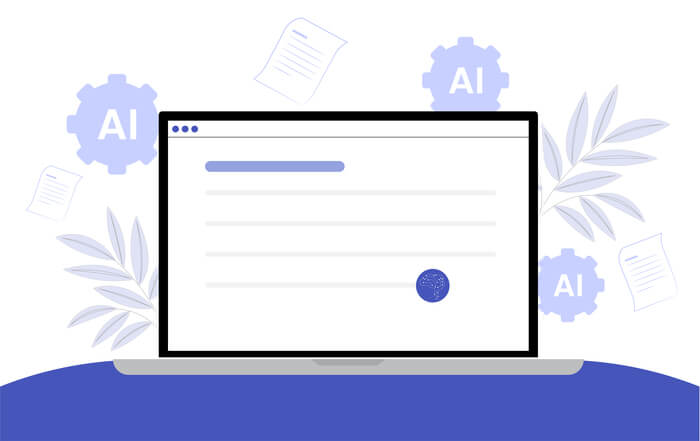This article was first published on the Flow SEO blog.
Content AI tools are gaining popularity in content marketing spheres. They are mostly used as copywriting tools to create shorter forms of content as well as ads for social media channels, but content marketers are also experimenting with the technology to write blog posts and longer articles.
Should content creators be concerned that writing content will become a job for Artificial Intelligence?
Which role can AI play in your content marketing strategy?
And how do the search engines look at this type of content?
These are just some of the questions this article will address. But first, let’s have a look at the evolution of Artificial Intelligence in content creation.
Understanding the Foundation
Machine-generated content isn’t something new. Natural Language Processing computer programs such as ELIZA have been around since the 1960s but for the longest time, the texts they produced were clearly computer-generated. They required detailed human input and could – especially in the beginning – only follow specific scripts to generate output.
Then came the content spinners. Spinners create “new” content by rewriting existing articles. The first tool of its kind that gained significant attention was ArticleBot, launched in 2005. The concept was simple: users would copy/paste content into the tool, and the tool would use that content to generate new texts. Spinners were (and in some cases still are) highly popular among certain types of SEO marketers, especially within affiliate marketing, and their use is generally considered black hat. However, they never produced high-quality articles, so content writers weren’t too worried about them.
Things started to change a few years ago when computers learned how to better and more independently interpret the rules and parameters they receive to generate new content. They also required less and less input. Central in this evolution has been the series of Generative Pre-trained Transformer (GPT) AI language models released by OpenAI. At the time of publication, the most recent GPT-3 model uses over 175 billion machine learning parameters.
While GPT-1, introduced in June 2018, was still pretty bad, GPT-2, released in February 2019, showed more potential, and GPT-3, launched in May 2020, made writers realize they’d soon need to think about what sets them apart from the machines.
More on that later.
For now, it’s enough to say that AI writing software has come a long way, but it’s not great yet, and it will probably take another one or two years before it can produce quality content consistently.
That’s because even though AI content tools have gotten better at reading and understanding our input, they still require quite a bit of handholding. These tools need us to pick the best out of the different variations they’ve generated, and then to manually polish them so that they read smoothly and fit our brand. They also need us to thoroughly fact-check whatever they’ve come up with
Maybe even more dangerous is the sexist and racist language GPT-3 tools have been seen to generate. While researchers are working hard on solving this issue, we currently still can’t trust that our AI text generator won’t produce results like the ones presented in the tweet below.
Knowing this, why are so many marketers hopping on the AI content train?
Because while not perfect yet, these tools tackle what so many writers loathe: the blank page. They’re great at giving you a starting point for your content so you can avoid writer’s block, and help you find the right language for your target audience.
Content AI Tools
Interested in trying them out? We’ve put together a list of some of the most popular AI content tools on the market right now. All relatively new, these tools are constantly tweaking both their features and pricing models.
Jasper, formally: Jarvis
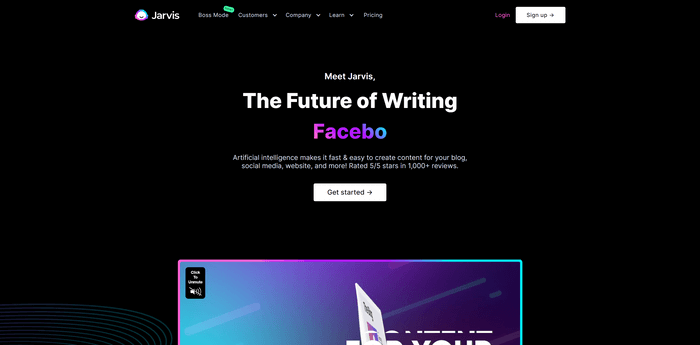
Jasper started under the name “Conversion AI”, then Jarvis and helps marketers create anything from Facebook ad copy to headlines, emails, and blog content. The tool currently works in and translates to 26 languages and allows you to tell it what tone of voice (funny, smart, …) to use.
It comes with a large variety of content templates as well as copywriting formulas, such as the AIDA framework and the PAS framework, and allows you to add team members to your account.
Jasper offers two different subscription plans that are billed monthly. There is no free trial but the brand does offer a seven-day money-back guarantee.
Copy.ai
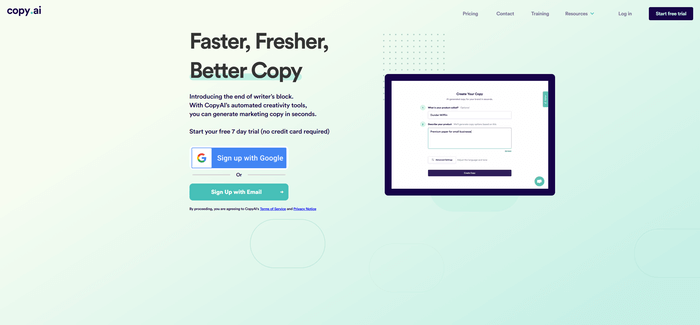
Copy.ai is an AI tool that offers you a range of text variations based on a description of what you want. You can choose the tone of voice, and you can do this for advertising copy, content for your social media channels, and product descriptions. The tool also comes with various copywriting formulas you can follow to write sales copy and it can even help you generate content ideas.
Unfortunately, you can’t use Copy.ai to write longer blog posts or emails that are less formulaic than your typical “Thank You” or order confirmation email.
The tool supports about 20 languages and there is only one pricing plan, billed annually or monthly, though larger teams have the option to request a custom quote to get access to more collaboration features.
Copysmith
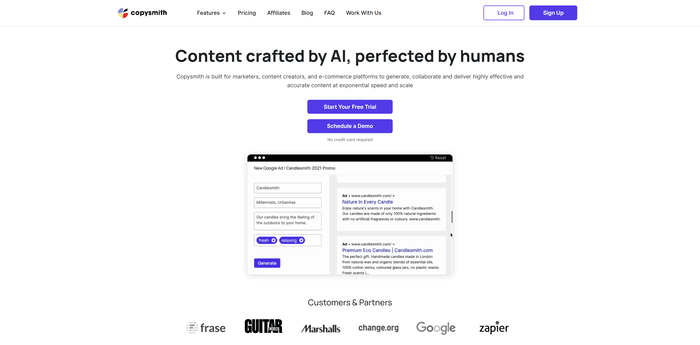
Copysmith helps you generate different types of marketing copy as well as short blog posts. Unfortunately, it doesn’t support the creation of long-form content.
One of Copysmith’s selling points is that it generates content word-by-word, ensuring you that every text is original and plagiarism-free. This AI content writer also provides over 30 copy and content templates. Another nice feature is that you can tell Copysmith which keywords to use or to avoid when generating ad copy.
Copysmith has three monthly pricing plans as well as a custom enterprise option and a free trial.
Headlime
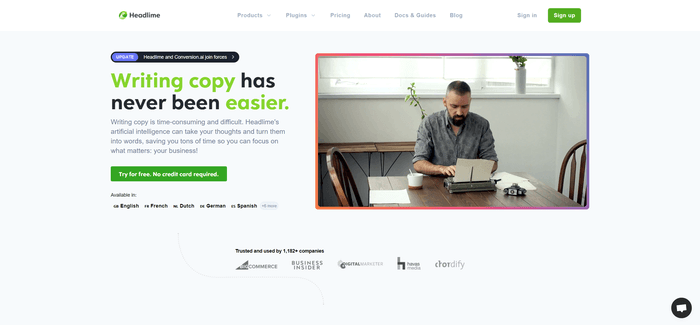
This AI tool doesn’t just allow you to specify the tone of voice of your content, as many of these tools do; it also allows you to choose how creative the AI can get. Another feature that makes Headlime stand out, is its ability to build entire landing pages, buttons, and pricing tables included.
The tool works great for the creation of product descriptions, shorter sales copy, and the creation of social media posts and ads, but the blog post generation feature is a bit lacking.
Headlime comes in 11 languages. It has an Individual and a Business pricing plan, as well as a free trial.
Writesonic
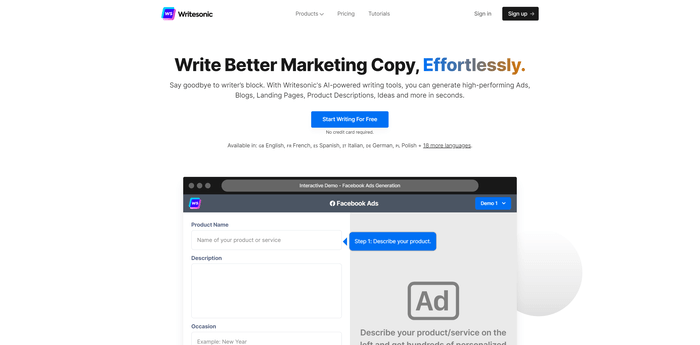
Writesonic helps marketers and writers create anything from website copy to advertisement copy, e-commerce copy, and even press releases. It assists with the generation of content ideas and while it’s not great at actual blog post creation, it does have a lot of features that make it easier to flesh out an article fast. These include the generation of introductions and outlines as well as a content expander.
Just like Headlimen, Writesonic also offers a complete landing page generator.
Writesonic is currently available in 20+ languages. It has four different pricing plans and also allows you to pay-as-you-go. The free trial consists of 10 credits to play with.
What Do We Do When Content Becomes so Cheap, Fast, and Scalable?
While AI content creation tools such as the ones listed above still can’t generate a high-quality long-form article that requires minimal content editing, they’re on their way there. And for some marketers, what they’re able to do is already enough to speed up the content creation process significantly.
Does that mean you need to start using content AI tools if you want to remain competitive?
Not necessarily.
One of the reasons AI content creation tools have grown so much in popularity is because they’re easy to use, and as Peep Laja from Wynter mentioned in his interview with Upraw Media, “whatever is easy to do, everybody will do”.
There is no true competitive advantage in something anyone can easily replicate. What you need, is to build a figurative moat around your online business. A moat is hard to cross, and it keeps your business safe from competitors.
But a moat is also hard to build. It takes time, effort, and strategy. In his book “7 Powers: The Foundations of Business Strategy”, author Hamilton Helmer lists 7 ways in which companies can set themselves apart and create moats that are hard for their competitors to jump over. These 7 powers are:
- Scale Economies: being able to do or produce more at a declining cost as your business grows.
Example: Amazon and its low prices + free shipping. - Network Economies: building a business in which the value for the customer increases the more customers the business gets.
Example: Facebook and its large user base. - Counter Positioning: adopting a new business model that is superior to the existing model(s) competitors adhere to and if competitors would try to mimic it, this would likely damage their business.
Example: Netflix eliminating the concept of late fees when “renting” movies. - Switching Costs: running a business that is hard for customers to move away from because of financial, procedural, and/or relational costs they would suffer.
Example: the time and hassle involved to switch from Hubspot to another CRM - Branding: establishing a brand with certain values and qualities that customers choose over other businesses with an identical offer because of those values and qualities.
Example: Drift. - Cornered Resource: securing the (exclusive) rights to a valuable resource at attractive terms so customers have no choice but to come to you for access to this resource.
Example: Microsoft partnering with OpenAI to exclusively license GPT-3. - Process Power: setting up your internal organization and procedures in such a way that they lead to lower costs and/or better products while competitors can only achieve the same results through long-term efforts.
Example: the Toyota Production System.
If human content creation can wield powers that AI content creation can’t, that means you can create a moat around your business that will make it hard, if not impossible for competitors to take over if they rely solely on Artificial Intelligence to get their content created.
To investigate whether that’s the case, I sat down with Flow SEO founder and CEO Viola Eva.
The powers of content AI
According to Viola, AI content creation tools have two powers that could give them a competitive advantage: Scale Economies and Process Power.
“Google loves big websites, and AI allows you to scale up your content production quickly and produce hundreds of pages in a relatively short period of time.” At the same time, it’s cheaper to let AI content creation tools generate a large amount of content than it is to pay writers to do the same.
“Content AI tools have their speed of implementation and low cost going for them. However, these are only true benefits if you don’t care about the quality and uniqueness of the content they generate, which are still lacking”, Viola continues.
According to Viola, AI content creation tools can help marketers with the creation of shorter form content, such as page titles, meta descriptions, and short-form articles that answer long-tail keyword questions, such as the ones you find in Google’s “People Also Ask” sections.
They’re also helpful for repetitive writing tasks, such as the creation of product and category descriptions on big e-commerce sites.
Content AI can help speed up the writing process at a low cost but as we saw, these powers are also what makes these tools accessible to so many marketers. They lack that difficulty level required to create a moat around your business.
The powers of human-written content
What about human-written content? What is a competitive advantage that is hard to achieve, and that can be gained through human writing but not with AI content writing?
Right now, it’s Brand.
“Getting someone to click your article or ad is one thing. You also want people to remember you. This is where your unique tone of voice, your brand personality, your website design, and user experience come in”, Viola states. “AI content creation tools can not make you stand out yet.” You need human brand-building as part of your content strategy to do that.
Peep Laja mentions this as well. According to him, “brand and positioning live in the mind of the user”. It’s very hard to log into someone’s mind and copy a brand from there. Much harder than it is to, for example, log into a software tool and copy the user design.
Building a brand requires more than taking a heap of source material and using that to build something new. A brand is carefully crafted and reinforced over time. It requires writers to take into account a set of rules and guidelines that right now, content AI software can’t fully comprehend yet. Things like perspective and personality are still inherently human.
So is how we consume content. We need more from an article than pure information. We want it to engage us, entertain us, and teach us. We want it to be well-structured and published on a site that loads fast and is easy to navigate. We want the full content experience.
While one of the powers of content AI is that it allows you to create more content faster, “content experience design helps us get off the treadmill of creating endless walls of text. It allows us to be creative and make more of the content we already have. It’s a tool to build trust, generate new leads, and truly stand out as a brand.” (Viola Eva on Search Engine Journal)
Lastly, creating content that offers a unique approach and/or perspective is one of the strategies you can use to become a thought leader in your industry and gather a loyal social media following, an engaged email list, and a large blog readership.
Just like content Artificial Intelligence can’t copy over a brand, it can’t copy over your following.
The problems of content AI
While we’ve already established that the powers of content AI aren’t sufficient to create a strong enough moat around your business, there are a few other issues we haven’t discussed yet.
THE QUESTION OF DATASETS
As Viola states, “it’s never really clear which datasets the Artificial Intelligence uses” and so you never know whether a generated text is based on reliable sources or not. This is very different from human content creation, where a writer can verify sources and discard them if necessary even before the writing process starts.
“Google focuses heavily on E-A-T (Expertise, Authority, and Trust), especially in niches such as finance, health, and legal. Content AI tools aren’t able to optimize for E-A-T as they currently don’t take into account the reputation of a source, nor do they fact-check.”
Of course, you can always fact-check yourself and edit an AI-generated piece of content for grammar and spelling mistakes. For shorter content, this is certainly doable. For longer articles, however, it might be more efficient to just do it right from the start and write the piece yourself (or hire someone to do so). This way, you also avoid missing a mistake the AI might have made or including information from unreliable sources.
DUPLICATION AND SIMILARITY
As AI software generates new content based on existing content, and many marketers may be using the same tool to generate content around the same topics, there’s a risk of ending up with (partially) duplicate content as well as very similar articles. While the similarities may not be as such that Google would pick up on them (although you never know), your target audience will surely notice and you’ll lose your chance to stand out as a brand.
COPYRIGHT
The topic of duplicate and similar content brings us to the issue of copyright. Right now, if your AI-generated piece of content infringes copyright, you or your company will be liable, not the AI software.
And then there is the question of whether your own AI-generated content would be protected under copyright laws. Right now, this is still very much a grey area, and according to Barucha & Partners “many jurisdictions are unwilling to confer copyright protection to works created by artificial persons.” The United States Copyright Office, for example, is currently not registering any claims for works that have not been created by humans.
Summary and Outlook
Artificial Intelligence can be a great supporting tool if you’re stuck with a blank page, bored with repetitive writing tasks, or want to find new variations on an idea. Especially when creating short content, such as page titles and advertisement copy, AI software can help you speed up your creation process at a low cost so you can focus on adding a unique point of view and creating a great content experience.
However, when you solely rely on these tools, their powers become their disadvantages. Content AI tools are relatively cheap and easy to use. As they’re accessible to every marketer, they’re not enough to build a solid moat around your business.
Human content creation is. It’s the tool that allows you to build a unique brand people won’t forget. The fact that it’s harder, takes more time, and costs more shouldn’t deter you. In fact, those three “downsides” are what will scare off your competitors and allow you to stand out.
If you’re still unsure if and how much you should use AI software, or whether you should stick with human content creation, Viola suggests you consider these questions:
“What do you want to stand for? How will you set yourself apart?” Will you be one in a dozen trying to cross the moat, or will you be the keeper of a fort unlike any other?
Content AI tools can play a supportive role in your content creation process, but if you’re a B2B brand like our clients are, you need the industry insights and creativity only humans can provide to stand out among your competitors. Want to know more? Get in touch.
